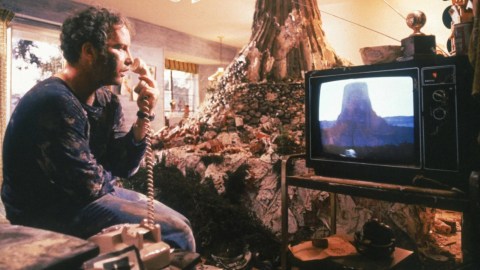17. 4. – 19. 4. 2026
Close Encounters of the Third Kind

 Original title: Close Encounters of the Third Kind
Original title: Close Encounters of the Third KindDirector: Steven Spielberg
Production: 1977, USA
Length: 138 min.
Screened:
KRRR! 2024: 70mm 2.2:1, Colours partly faded, MG Dolby A BB, Spoken language: English, Subtitles: CzechAnnotation for KRRR! 2024
Steven Spielberg was just 30 years old when he released the commercially successful and critically acclaimed Close Encounters of the Third Kind in 1977, confirming his status as one of Hollywood's most important filmmakers. Unlike the extensive television work he had done between 1969 and 1973, and unlike his two previous films for the cinema – The Sugarland Express (1974) and Jaws (1975) – Close Encounters was a very personal project for Spielberg. Not only is it one of the few films for which he wrote the script himself, but the idea for it goes back to his own amateur filmmaking.
He shot the impressive Firelight as a teenager on 8mm film, it ran 135 minutes and even got a real screening to a paying audience in his hometown in 1964. Of course, the budget and format of the film had changed, so Close Encounters no longer cost $500 but $20 million, and was shot not on 8mm film but on 70mm film. What it did retain, however, was the attention paid to a crumbling partnership on the one hand and contact with aliens on the other. Spielberg's recent autobiographical film The Fabelmans (2022) reminded us just how crucial a dysfunctional relationship, and ultimately the break-up of his parents, was to his life and filmmaking.
Close Encounters takes the theme of the breakdown of personal relationships to an extreme. Although people tend to remember most vividly from the film the glorious, truly amazing spectacle of the UFO apparition, especially the landing of the mothership at the end, for most of the time the film is concerned with Roy Neary. He, in a sense, loses his mind, his job and his family as he obsessively tries to find answers to the question of what the strange experience he went through "means". In parallel, the film tells the story of single mother Jillian, whose young son is taken away by unknown forces in one particularly disturbing scene, and she desperately tries to get him back.
In retrospect, Spielberg had mixed feelings about Close Encounters, especially its conclusion. In 1980, a "special edition" was released to theaters, for which he shot new material, but he also scrapped some scenes from the original film. He then assembled a "collector's edition" from both versions in 1998, which was released on videocassette, laserdisc and other formats – whereupon it received a short theatrical run a year later. Spielberg also felt that he portrayed Roy Neary's behaviour, as he pushes his wife and children away, too uncritically. This subsequently inspired him to tell the story of a woman and her children who must cope with the departure of their husband and father in what is arguably Spielberg's most successful film, E.T.: The Extra-Terrestrial (1982).